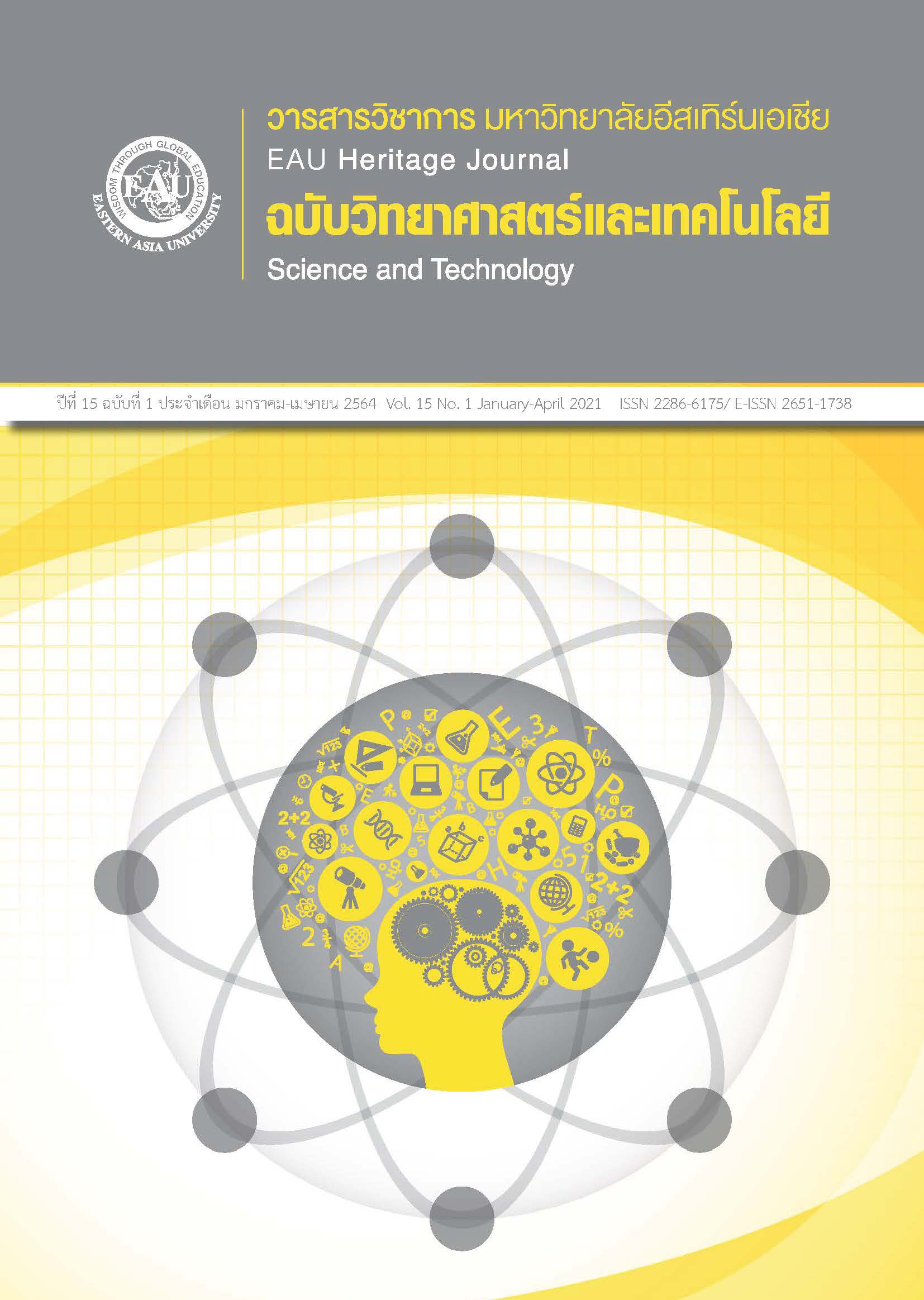ปัจจัยแห่งความสำเร็จในการเรียนรู้การควบคุมจราจรทางอากาศ
คำสำคัญ:
การควบคุมจราจรทางอากาศ, การเรียนรู้, ปัจจัยแห่งความสำเร็จ, กระบวนการลำดับชั้นเชิงวิเคราะห์บทคัดย่อ
งานวิจัยนี้มีวัตถุประสงค์เพื่อ จัดลำดับความสำคัญของปัจจัยแห่งความสำเร็จในการเรียนรู้การควบคุมจราจรทางอากาศ โดยใช้วิธีกระบวนการลำดับชั้นเชิงวิเคราะห์ (Analysis Hierarchy Process--AHP) และใช้สถาบันการบินพลเรือน (สบพ.) เป็นกรณีศึกษา เครื่องมือในงานวิจัยครั้งนี้ ได้แก่ แบบประเมินความเหมาะสมของปัจจัยแห่งความสำเร็จในบริบทของ สบพ. และแบบสอบถามสำหรับการเปรียบเทียบเชิงคู่ตามระเบียบวิธี AHP งานวิจัยนี้เริ่มจากการทบทวนวรรณกรรมที่เกี่ยวข้องกับดัชนี้ชี้วัดความสำเร็จและปัจจัยแห่งความสำเร็จในการเรียนรู้ จากนั้นแบบประเมินความเหมาะสมที่พัฒนาขึ้นเพื่อประเมินความเหมาะสมของปัจจัยเบื้องต้นที่ได้จากการทบทวนวรรณกรรมที่เกี่ยวข้องได้นำมาใช้เก็บข้อมูลความเหมาะสมของปัจจัยในบริบทของ สบพ. โดยผู้ตอบแบบประเมินคือผู้ฝึกสอนจาก สบพ. จำนวน 20 คน โดยข้อมูลที่เก็บรวบรวมได้จะนำมาทดสอบความเหมาะสมโดยการวิเคราะห์สถิติ t-test ที่ระดับนัยสำคัญ .05 ผลการทดสอบสรุปได้ว่า ในมุมมองของผู้ฝึกสอน มีปัจจัยจำนวน 17 ปัจจัยที่มีความเหมาะสมที่จะเป็นปัจจัยแห่งความสำเร็จในการเรียนรู้การควบคุมจราจรทางอากาศ และเมื่อนำปัจจัยแห่งความสำเร็จเหล่านี้มาจัดลำดับความสำคัญโดยใช้วิธี AHP โดยผู้เชี่ยวชาญที่ทำการตอบแบบสอบถามการเปรียบเทียบเชิงคู่ คือ ผู้ที่มีประสบการณ์ด้านการควบคุมจราจรทางอากาศจำนวน 14 คน ซึ่งผลการวิจัยพบว่า ปัจจัยแห่งความสำเร็จที่มีค่าคะแนนความสำคัญมากที่สุดสามอันดับแรก คือ การฝึกการปฏิบัติงานจริง การวางแผนการฝึกปฏิบัติที่เหมาะสม และองค์ความรู้เกี่ยวกับการควบคุมจราจรทางอากาศและข้อตกลงต่าง ๆ ของผู้เรียน ตามลำดับ
เอกสารอ้างอิง
Angelova, B., & Zekiri, J. (2011). Measuring customer satisfaction with service quality using American Customer Satisfaction Model (ACSI Model). International Journal of Academic Research in Business and Social Sciences, 1(3), 232-258. doi: 10.6007/ijarbss.v1i2.35
Aydin, O. T. (2012a). The impact of motivation and hygiene factors on research performance: an empirical study from a Turkish University. International Review of Management and Marketing, 2(2), 106-111. https://www.econjournals.com/index.php/irmm/article/viewFile/180/109
Bagwan, A. K., & Bhola, S. S. (2018). Awareness and significance of e-banking among rural India. Pravara Management Review, 17(1), 46-52. https://bit.ly/3a4fXiB
de Reuck, S., Donald, F., & Siemers, I. (2014). Factors associated with safety events in air traffic control. Ergonomics SA, 26(1), 2-18.
Gardi, A., Sabatini, R., & Ramasamy, S. (2016). Multi-objective optimization of aircraft flight trajectories in the ATM and avionics context. Progress in Aerospace Sciences, 83, 1-36. doi: 10.1016/j.paerosci.2015.11.006
Gorsevski, P. V, Jankowski, P., & Gessler, P. E. (2006). An heuristic approach for mapping landslide hazard by integrating fuzzy logic with analytic hierarchy process. Control Cybern, 35, 121–146. http://matwbn.icm.edu.pl/ksiazki/cc/cc35/cc3517.pdf
International Civil Aviation Organisation (ICAO). (2001). Procedures for air navigation services. air traffic management, Doc 4444, International Civil Aviation Organization. Canada: International Civil Aviation Organization.
International Civil Aviation Organisation (ICAO). (2016). Manual on air traffic controller competency-based training and assessment, Doc 10056, International Civil Aviation Organization. Canada: International Civil Aviation Organization.
International Civil Aviation Organisation (ICAO). (2018). Air traffic services, Annex 11, International Civil Aviation Organization. Canada: International Civil Aviation Organization
ISO/DIS 22400-2. (2014). Automation systems and integration—key performance indicators for manufacturing operations management-Part 2: Definitions and descriptions. Switzerland: ISO 22400-2:2014
Khan, I., Zameer, Q. A., & Burney, M. T. (2018). Impact of naming under ‘international’ tag on the brand equity of private universities. International Journal of Techno-Management Research, 5(4), 43-53. http://www.ijtmr.com/docs/vol5/ma18(7).pdf
Khan, S., Nabi, A. A., & Hafeez, A. (2016). Factors affecting tourism in northern areas of Pakistan. Journal of Economic Info, 3(4), 1-6. https://doi.org/10.31580/jei.v3i4.90
Komnamool, N. (2008). Aviation techonology and airport industry. Bangkok: Project Spreading Science for National Development. (in Thai)
Kuany, M. D. W. (2012). Improving my professional practice and students’ learning skills through action learning in economics education: a pedagogical action research conducted at dr. JG-Must, South Sudan (Master's thesis). OsloMet – Oslo Metropolitan University. Oslo, Norway
Kruglyak, A. (2010). Modeling and simulation of embedded real-time software (Master’s thesis). Luleå University of Technology. Swedish.
Madu, C. N., & Georgantzas, N. C. (1991). Strategic trust of manufacturing automation decisions: A conceptual framework. IIE Transactions, 23(2), 138-148. https://doi.org/10.1080/07408179108963849
Madu, C. N., Kuei, C. H., & Madu, A. N. (1991). Establishing priorities for the information technology industry in Taiwan: a Delphi approach, Long-Range Planning, 24(5), 105-118.
Panprasit, D., & Somsuk, N. (2016). A study on the relationship between human factors and air traffic control’s training achievement (Master’s thesis). Eastern Asia University. Pathum Thani. (in Thai)
Poku, J., Asare, M. B., & Ricky, W. (2017). Scrutiny of customer satisfaction with service delivery of mobile telecommunication networks: A case of Navrongo. International Journal of Statistics and Actuarial Science, 1(3), 78-86. doi: 10.11648/j.ijsas.20170103.12
Reeves, S. (2005). Key elements for interprofessional education. Part 1: The learner, the educator and the learning context. Journal of Interprofessional care, 19(sup1), 21-38. https://doi.org/10.1080/13561820500083550
Rockart, J. F. (1979). Chief executives define their own data needs. Harvard business review, 57(2), 81-93. https://hbr.org/1979/03/chief-executives-define-their-own-data-needs.
Saaty, T. L. (2005). Theory and applications of the analytic network process: Decision making with benefits, opportunities, costs, and risks paperback (3rd ed.). USA.: RWS Publications.
Saaty, T. L. (1980). The analytic hierarchy process: Planning, priority setting, resource allocation. New Yor: McGraw-Hill.
Saaty, T. L., & Vargas, L. G. (1998). Diagnosis with dependent symptoms: Bayes theorem and the analytic hierarchy process. Operations Research, 46(4), 491-502. doi: 10.1287/opre.46.4.491
Saaty, L. T., & Vargas, L. G. (2012). Models, methods, concepts and applications of the analytical hierarchy process (2nd ed.). New York: Springer Publishers
Shahin, A., & Mahbod, M. A. (2007). Prioritization of key performance indicators: an integration of analytical hierarchy process and goal setting. International Journal of Productivity and Performance Management, 56(3), 226-240. doi: 10.1108/17410400710731437
Srinual, N., Nongpa, A., Sinrat, S., Chamsuk, W., & Yaklai, P. (2016). Application of the Analytic Hierarchy Process on Warehouse Location Selection Factors. Business Review Journal, 8(2), 75-90. (in Thai)
Suklertnuntakij, P. (2001). Development of air traffic controller competence in Bangkok airport. Bangkok: Ramkhamhaeng University (in Thai)
Teesuka, P., & Uamcharoen, S. (2015). The development of teaching model: Curriculum development course by using reseach based learning approach for pre-service teachers academic base for curriculum development for teacher professional students. Silpakorn Educational Research Journal, 7(1), 135-147. (in Thai)
Updegrove, J., & Jafer, S. (2017). Optimization of air traffic control training at the federal aviation administration academy. Aerospace, 4(4), 50. https://doi.org/10.3390/aerospace4040050
van der Klink, M. R., & Streumer, J. N. (2002). Effectiveness of on-the-job training. Journal of European Industrial Training, 26(2/3/4), 196-199. https://doi.org/10.1108/03090590210422076.
Winebrake, J. J., & Creswick, B. P. (2003). The future of hydrogen fueling systems for transportation: an application of perspective-based scenario aanalysis using the analystic hierarchy process. Techological Forecasting and Social Change, 70(4), 359-384. doi: 10.1016/S0040-1625(01)00189-5
Yadav, G. (2018). Product characteristics that influence consumer purchasing decisions of small cars. International Journal of Research Granthaalayah, 6(1), pp. 463-469. https://doi.org/10.29121/granthaalayah.v6.i1.2018.1655







